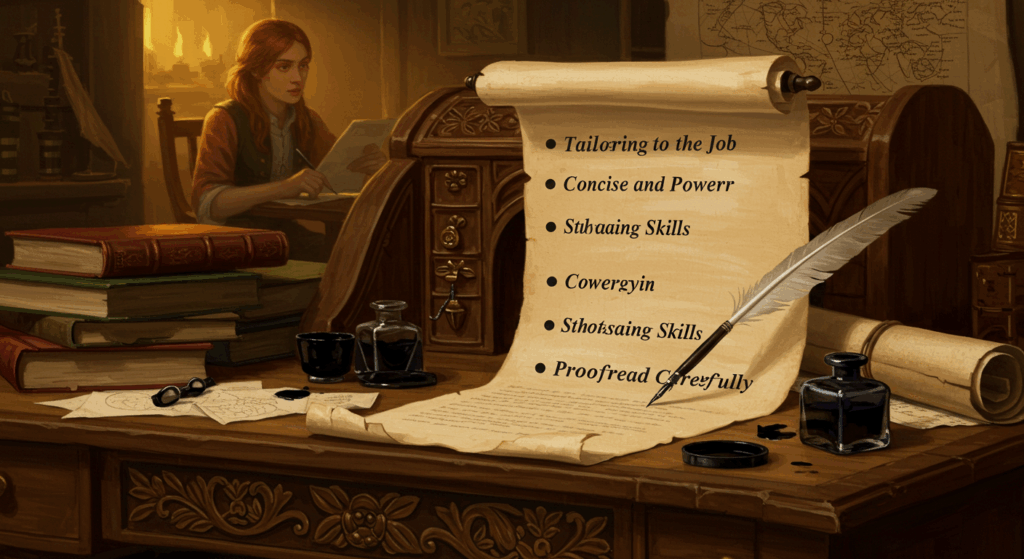If you’ve ever stared at a blank Google Doc thinking “uhhh, how do I build a cover letter from scratch to finish without sounding like a robot?”—same. The good news is: this is easier than it looks, and yes, you can totally make it feel like you. Think less stiff corporate memo, more thoughtful DM to the hiring manager (minus the emojis… okay, maybe just one tasteful emoji in your head while writing). Grab a coffee, crack your knuckles, and let’s build a cover letter you’ll be low-key proud to send.
The Vibe Check: What a Cover Letter Really Does
A cover letter isn’t your resume copy-pasted into sentences. It’s your chance to add context, show personality, and connect the dots between your experience and what that company needs. If your resume is the movie trailer, the cover letter is you whispering, “psst, here’s why this movie slaps.” It helps the reader see your judgment, your voice, and your motivation. Ngl, it can be the difference between “hmm, maybe” and “bring them in.”
Think of this whole thing as a simple journey from scratch to finish: you’ll pick your angle, explain your value with receipts, keep it tidy, and end with a confident ask. We’ll walk the route together, step by step, in a way that’s chill but effective.
From Scratch to Finish: A Simple Game Plan
We’ll use three stages to make the process feel human and manageable:
- Research & Aim — figure out what the company actually cares about (no guesswork).
- Write the Core — assemble the building blocks: intro, hook, proof, fit, and ask.
- Polish & Send — do the final touches, formatting, and little fixes that scream “I’m detail-oriented.” (But like, not in a try-hard way.)
By the end, you’ll have a clean letter that sounds like you and answers the hiring manager’s silent question: “Why should I care?”
Step 1: Research That’s Actually Useful (and fast)
Before writing, you need clues; otherwise you’re just guessing. The goal is to learn enough to tailor your letter without spending an entire Sunday deep-diving like it’s a new Netflix doc.
What to look for
- The role’s real priorities: Look at the top 4–6 responsibilities in the job post. If “optimize onboarding” shows up twice, guess what matters.
- Company goals/voice: Read the About page, skim a blog post, check their LinkedIn. Are they scrappy? customer-obsessed? data-driven?
- One proof-friendly metric: What can you point to in your experience that lines up with their needs—revenue, growth, engagement, speed, cost, quality, customer happiness?
Quick research cheats
- Highlight keywords in the job ad (sales enablement, lifecycle email, A/B testing, stakeholder alignment).
- Peek at recent wins (product launches, funding, partnerships) so your letter feels current.
- Find a name if possible. A real greeting beats “To Whom It May Concern” like, every time.
Okay—now you’re not guessing. You’re aiming.
Step 2: The Building Blocks of a Great Cover Letter
This is the part where we build the letter from scratch to finish using simple building blocks that never fail. Keep it to one page, ideally 300–450 words. You’re writing a pitch, not a podcast transcript.
1) Header (keep it clean)
Name, phone, email, LinkedIn (or portfolio), location (optional), date, and the company’s details. Consistent with your resume. No need to get fancy; clean beats “experimental.”
2) Greeting (say hi like a human)
- Best: “Hi [Hiring Manager’s Name],”
- Good: “Hi [Team Name] Hiring Team,”
- Avoid: “Dear Sir/Madam” (it’s giving fax machine).
3) Opening Hook (what’s your angle?)
In two lines, connect who you are to what they need—directly. Skip “I’m writing to express my interest.” They know. Try:
“I’m a lifecycle marketer who’s grown activations 30%+ at early-stage SaaS teams, and I’m excited about [Company]’s push into self-serve. Your focus on onboarding experiments? That’s my jam.”
Boom. Angle set. Now they have a reason to keep reading.
4) Proof (show receipts)
This is your mini-portfolio in two short paragraphs or a tight bullet set. Use numbers if you’ve got ‘em. You’re answering: “Can this person ship results here?”
- What I did → How I did it → Result
- Tie the result to the role’s language.
Example:
- “Led onboarding email experiments using Mixpanel + Braze; improved D7 activation from 18% to 27%.”
- “Launched self-serve flows with Product + Support; cut time-to-value by 22%.”
- “Built a customer feedback loop; NPS jumped from 36 → 51 in two quarters.”
Short, sharp, relevant. (Also, chef’s kiss if you can combine metrics + collaboration.)
5) Fit (why them, why now)
This is where you show you “get” the company—without writing a book report. One short paragraph tying your experience to their priorities.
“Your move into SMB and recent Shopify integration stood out to me. I’ve shipped onboarding for similar merchants and can help your team scale testing without sacrificing customer trust.”
You’re not just applying; you’re aligning.
6) Close (confident but not cringe)
End with energy and a clear nudge for next steps.
“I’d love to share how we can bring your activation target forward this quarter. If it’s helpful, I can walk through the experimentation roadmap I used to lift conversion at [Previous Company]. Thanks for the time—talk soon?”
Add your name. That’s it. No overly formal “With the utmost sincerity and warmest regards.” You’re not writing to a duke.
A Quick Sample (So You Can Hear the Flow)
Hi Maya,
I’m a content-to-conversion marketer who’s grown signup → trial conversion 25%+ at two B2B SaaS startups, and I’m excited about Arcwell’s push into self-serve. Your focus on onboarding experiments and customer education? That’s very much my lane.At LatticePath, I built a lifecycle email + in-app education loop with Product and Support, improving D7 activation from 21% to 29% over one quarter. I also launched a “fast start” resource hub and added interactive checklists in-product, which reduced support tickets about setup by ~18%. Prior at Peakly, I ran pricing page tests that lifted trial starts 14%, pairing copy updates with social proof placement.
What pulls me to Arcwell is your bet on small merchants. I’ve worked hands-on with similar users, and I’m comfortable prioritizing experiments that respect their time and attention. I’d love to help you scale onboarding content that feels like a coach, not a lecture.
If helpful, I’m happy to share a simple activation dashboard and test backlog that made alignment easy across Product, Design, and RevOps. Thanks for reading—looking forward to connecting.
—Alex Rivera
Short, friendly, and focused. It showcases building blocks without sounding like a template.
Tone Tips: Sound Like You (But Hireable)
- Conversational, not sloppy. Use contractions. Say what you’d say out loud (cleaned up).
- Avoid buzzword soup. “Synergies” and “leverage” are fine, just… sparingly.
- Specific over vague. “Improved onboarding” < “Improved D7 activation 21% → 29% with checklists + emails.”
- A tiny dash of personality. A light “I’m obsessed with clean dashboards” or “I care a lot about delightful UX” goes a long way.
- Keep it positive. No shade at former employers; this is a highlight reel, not Yelp.
Formatting That Won’t Fight the ATS
Let’s keep the final touches clean. You want readability on any screen and zero “why is this broken” issues.
- Length: 300–450 words; one page.
- Font: system fonts (Arial, Calibri, Helvetica). Size 11–12.
- Margins: ~1 inch.
- File type: PDF unless they say otherwise.
- Links: Hyperlink your portfolio/LinkedIn. Keep URLs clean.
- Whitespace: Short paragraphs (2–4 lines). Recruiters skim like they’re late for a flight.
Match Your Letter to the Role Type
Because one size never fits all (looking at you, “Dear Sir/Madam” template).
Entry-Level or New Grad
- Lean on projects, internships, and coursework with outcomes.
- Show momentum: what you learned, how fast you iterate.
- Mention tools you actually used (Figma, SQL, Python, Canva, GA4).
Career Switch
- Translate your transferable skills (“I ran stakeholder workshops” → “I can gather requirements and align teams”).
- Anchor with a project relevant to the target role (a portfolio or personal build helps).
- Address the pivot in one brave sentence; don’t apologize for it.
Experienced Hire
- Focus on impact + scope. Team leadership, budgets, cross-functional wins.
- Pick 2–3 meaty examples with metrics.
- Mention how you’ve mentored or scaled processes.
Creative Roles
- Voice can be a little bolder (within brand).
- Include one distinct POV (e.g., “Design should reduce cognitive load like a good tour guide”).
- Link to portfolio prominently.
Technical Roles
- Keep it crisp; skip fluff.
- Show systems thinking and context (tradeoffs, incident response, perf wins).
- Mention the stack sparingly (don’t list 40 tools).
Avoid These Common Traps (no shade, we’ve all been there)
- Rewriting your resume in paragraph form (zzz).
- Being generic: If your letter could go to any company, it will work for none.
- Over-explaining your life story. Save the autobiography for your memoir.
- Humble-shrugging your wins (“I kind of helped with…” No. You did the thing.)
- Begging energy: You want this job, yes; but you also bring genuine value. That’s the posture.
From Scratch to Finish: A Repeatable Mini-Template
Use this as your 10-minute build. It keeps the building blocks tight.
Greeting: Hi [Name],
Hook: I’m a [role/skill] who’s [result], and I’m excited about [company initiative/goal].
Proof (2–4 bullets or 1–2 micro-paragraphs):
- [Action you took] → [Tool/approach] → [Result/metric]
- [Cross-team collab] → [Outcome]
Fit (1 short paragraph): Why you + them makes sense now.
Close: I’d love to [specific next step]. Happy to share [asset/demo]. Thanks for reading—talk soon.
Signature
Copy that into a doc and fill the blanks. Boom. From scratch to finish in one sitting.
Tiny Phrases You Can Borrow (No Shame)
Opening ideas:
- “I love that you’re [doing X]; I’ve shipped [similar thing] and can help you scale it.”
- “At [Current/Last Company], I [did X] which [drove Y]. I’m excited to bring that playbook to [Company].”
- “I care a lot about [specific user outcome]. Your [mission/product] lines up, which is why I’m excited about this role.”
Closing ideas:
- “If helpful, I can share a quick walkthrough of [project] and what I’d test first for [Company].”
- “I’d love to compare notes on your [goal] and how we can accelerate it this quarter.”
- “Thanks for the time—looking forward to connecting.”
Powerful Verbs (because “responsible for” is sleepy)
Built, shipped, launched, led, designed, automated, refactored, optimized, accelerated, stabilized, orchestrated, aligned, simplified, coached, scaled, piloted, validated, unlocked, de-risked, mapped, streamlined, integrated, championed, delivered.
Sprinkle, don’t carpet-bomb.
Add the Final Touches: A Quick Checklist
Here’s your last mile. The final touches are how your letter goes from “nice” to “neat.”
- Name check: Spelled the hiring manager’s name right? (triple check pls)
- Company details: Name, product, and role title all accurate?
- Voice check: Reads like you? Not a corporate template?
- Relevance: Every sentence earns its place. If it’s fluff, cut it.
- Metrics: At least one number or concrete outcome.
- Format: Clean fonts, short paragraphs, one page.
- Links: Portfolio/LinkedIn work and aren’t broken.
- File name:
Firstname-Lastname-Cover-Letter-Company-Role.pdf(tiny thing, big signal). - CTA: Clear next step in the close (chat, walkthrough, roadmap).
- Read-aloud test: If you cringe reading it out loud, tweak till it flows.
Optional spice
- Add a P.S. if it adds value, not noise. Example: P.S. I also built a tiny onboarding demo that shows how I’d approach your first-week experience. Happy to share the link.
Examples You Can Remix (Short and Sweet)
1. Example A: Early-Career Marketing
Hi Jordan,
I’m a junior marketer who turned a scrappy newsletter into a 14k-subscriber growth engine in nine months, and I’m excited about LocalLoom’s push into community-powered content.I launched a weekly “how-to” series, pairing TikTok cuts with blog deep dives; average CTR rose from 2.9% to 5.4%. I also built a simple calendar + UGC pipeline that cut production time ~25% and doubled replies.
I admire LocalLoom’s practical, no-ego voice. I’d love to help you scale content that earns trust with real, useful stories. Happy to share my content map and test backlog if helpful. Thanks for your time—talk soon!
—Riley Chen
2. Example B: Product Manager, Career Switch from Ops
Hi Anika,
After three years running ops at a fast-growing D2C brand, I moved into product, where I’ve shipped small improvements that made big user dents—like reducing returns by 12% with clearer PDP sizing help. Threadway’s mission to remove friction for online shoppers resonates a lot.In ops, I led weekly triage, mapped failure points, and worked with Engineering on an internal returns tool; later, as an APM, I partnered with Design on a PDP experiment that cut “where’s my order?” tickets ~9%.
I’d love to bring that ops-meets-product lens to Threadway. If useful, I can share a quick Loom on how I prioritize low-cost, high-impact fixes. Appreciate your time!
—Sam Patel
3. Example C: Engineer, Experienced
Hi Chris,
I’m a backend engineer who’s scaled event pipelines to billions/day with <150ms p95, and I’m excited about Northbeam’s reliability-first culture.At Spline, I led a Kafka → Pulsar migration that cut infra cost ~18% and stabilized comnsumer lag during spikes. I also introduced a canary deploy process that dropped rollback incidents from 4/month to <1.
I’d love to help strengthen Northbeam’s ingestion layer and share a playbook for clean handoffs with Data Science. Thanks for reading—open to a quick chat this week.
—Devin Morales
FAQ-ish: Things People Always Ask (and the real talk answers)
Do I need a cover letter for every job?
If the posting asks for it or the role is competitive, yes. Also yes when a referral or networking angle is involved. If the application is literally “upload resume only,” you can skip it… but including one often helps.
What if I have no direct experience?
Lean on projects, internships, coursework, volunteer work, and transferable skills. Show how you learn fast and where you already delivered outcomes.
How formal should I sound?
Match the company’s voice. Enterprise bank? A notch more formal. Startup with memes on their careers page? Friendly professional. Either way, clear > clever.
How do I not sound cringe?
Be specific, be honest, cut fluff. Write like a person you’d want to work with. If a sentence makes you wince, delete it. (This is the way.)
Can I use AI to draft?
Sure, but always personalize. Add your own metrics, your voice, and your research. AI can help brainstorm; you own the story.
From Scratch to Finish: A 20-Minute Sprint Plan
If you’ve got only 20 minutes between calls, use this:
- Minute 0–4: Scan the job description; highlight 5 priority keywords.
- Minute 5–7: Skim the About page + 1 recent post/update.
- Minute 8–12: Draft your hook + 2 proof bullets with metrics.
- Minute 13–16: Write the fit paragraph and a confident close.
- Minute 17–20: Do final touches (spell names, fix links, export PDF, file name).
It’s not about perfection; it’s about clarity and relevance.
Building Blocks Recap (sticky-note edition)
- Hook: Who you are + why this role now.
- Proof: 2–4 relevant wins with numbers.
- Fit: Why you + them makes sense.
- Close: Clear next step.
- Polish: Formatting, links, file name, read-aloud pass.
You can reuse this structure every time. It’s your kit of building blocks that always stacks into something solid.
Tiny Extras That Can Push You Over the Line
- Attach a one-pager or mini case if the role is big on strategy. Keep it simple and skimmable.
- Refer to a shared connection or a company moment (new launch, funding) if authentic.
- Offer something concrete in the close (a dashboard, roadmap sketch, quick teardown).
- Follow up in a week with a kind nudge (“bumping this in case it slipped down the inbox”). Short, polite, done.
Final Touches: A Micro-Editing Pass (out loud, yes really)
Read your letter out loud once. You’ll catch everything that “looks fine” but sounds weird. Trim adverbs, fix stacked clauses, and kill any sentence that starts with “I am writing to inform you that…” (we get it). Make sure from scratch to finish the energy stays confident, clear, and grounded in value.
A last quick checklist
- Does the opening make me want to keep reading?
- Did I prove impact with at least one metric?
- Do I explain why this company (not just “I love your mission”)?
- Is the close direct and friendly?
- Would I be proud for the hiring manager to forward this?
If yes, ship it. Seriously. Over-editing is just procrastination in a tuxedo.
Wrap-Up: You’ve Got This
Look, writing a cover letter doesn’t need to be paimful. With a little research, a clean structure, and those final touches, you can move from scratch to finish faster than you think—and with way more personality than any template. The goal isn’t perfection; it’s connection. Speak to what the team needs, bring your receipts, and show you’re the person who’ll make their life easier (and maybe even fun).
Now go build yours. Open a doc, drop in the building blocks, and give yourself 20 minutes to draft. Hit send, take a breath, and keep the momentum. You’re closer than you think.
Call to action: Pick one role you’re excited about, write the hook + two proof bullets right now, and paste them into a fresh doc. Momentum beats perfection—let’s get you that interview.Thinking.









